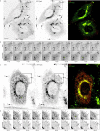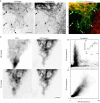Rab6 coordinates a novel Golgi to ER retrograde transport pathway in live cells
- PMID: 10562278
- PMCID: PMC2156170
- DOI: 10.1083/jcb.147.4.743
Rab6 coordinates a novel Golgi to ER retrograde transport pathway in live cells
Erratum in
- J Cell Biol 2000 Jan 10;148(1):followi
Abstract
We visualized a fluorescent-protein (FP) fusion to Rab6, a Golgi-associated GTPase, in conjunction with fluorescent secretory pathway markers. FP-Rab6 defined highly dynamic transport carriers (TCs) translocating from the Golgi to the cell periphery. FP-Rab6 TCs specifically accumulated a retrograde cargo, the wild-type Shiga toxin B-fragment (STB), during STB transport from the Golgi to the endoplasmic reticulum (ER). FP-Rab6 TCs associated intimately with the ER, and STB entered the ER via specialized peripheral regions that accumulated FP-Rab6. Microinjection of antibodies that block coatomer protein I (COPI) function inhibited trafficking of a KDEL-receptor FP-fusion, but not FP-Rab6. Additionally, markers of COPI-dependent recycling were excluded from FP-Rab6/STB TCs. Overexpression of Rab6:GDP (T27N mutant) using T7 vaccinia inhibited toxicity of Shiga holotoxin, but did not alter STB transport to the Golgi or Golgi morphology. Taken together, our results indicate Rab6 regulates a novel Golgi to ER transport pathway.
Figures











Similar articles
-
Evidence for a COP-I-independent transport route from the Golgi complex to the endoplasmic reticulum.Nat Cell Biol. 1999 Nov;1(7):423-30. doi: 10.1038/15658. Nat Cell Biol. 1999. PMID: 10559986
-
Intracellular phospholipase A1gamma (iPLA1gamma) is a novel factor involved in coat protein complex I- and Rab6-independent retrograde transport between the endoplasmic reticulum and the Golgi complex.J Biol Chem. 2009 Sep 25;284(39):26620-30. doi: 10.1074/jbc.M109.038869. Epub 2009 Jul 24. J Biol Chem. 2009. PMID: 19632984 Free PMC article.
-
Yip1A regulates the COPI-independent retrograde transport from the Golgi complex to the ER.J Cell Sci. 2009 Jul 1;122(Pt 13):2218-27. doi: 10.1242/jcs.043414. Epub 2009 Jun 9. J Cell Sci. 2009. PMID: 19509059
-
The trials and tubule-ations of Rab6 involvement in Golgi-to-ER retrograde transport.Biochem Soc Trans. 2014 Oct;42(5):1453-9. doi: 10.1042/BST20140178. Biochem Soc Trans. 2014. PMID: 25233431 Review.
-
Rab6-mediated retrograde trafficking from the Golgi: the trouble with tubules.Small GTPases. 2023 Dec;14(1):26-44. doi: 10.1080/21541248.2023.2238330. Small GTPases. 2023. PMID: 37488775 Free PMC article. Review.
Cited by
-
Molecular structure of membrane tethers.Biophys J. 2012 Apr 18;102(8):1866-71. doi: 10.1016/j.bpj.2012.03.048. Biophys J. 2012. PMID: 22768942 Free PMC article.
-
The roles of Syx5 in Golgi morphology and Rhodopsin transport in Drosophila photoreceptors.Biol Open. 2016 Oct 15;5(10):1420-1430. doi: 10.1242/bio.020958. Biol Open. 2016. PMID: 27591190 Free PMC article.
-
Golgi positioning: are we looking at the right MAP?J Cell Biol. 2005 Mar 28;168(7):993-8. doi: 10.1083/jcb.200501088. Epub 2005 Mar 21. J Cell Biol. 2005. PMID: 15781478 Free PMC article. Review.
-
The small GTPase Rab13 regulates assembly of functional tight junctions in epithelial cells.Mol Biol Cell. 2002 Jun;13(6):1819-31. doi: 10.1091/mbc.02-02-0029. Mol Biol Cell. 2002. PMID: 12058051 Free PMC article.
-
Giantin Is Required for Post-Alcohol Recovery of Golgi in Liver Cells.Biomolecules. 2018 Nov 16;8(4):150. doi: 10.3390/biom8040150. Biomolecules. 2018. PMID: 30453527 Free PMC article.
References
-
- Antony C., Cibert C., Geraud G., Santa Maria A., Maro B., Mayau V., Goud B. The small GTP-binding protein rab6p is distributed from medial Golgi to the trans-Golgi network as determined by a confocal microscopic approach. J. Cell Sci. 1992;103:785–796 . - PubMed
-
- Balch W.E., McCaffery J.M., Plutner H., Farquhar M.G. Vesicular stomatitis virus glycoprotein is sorted and concentrated during export from the endoplasmic reticulum. Cell. 1994;76:841–852 . - PubMed
-
- Cohen A., Hannigan G.E., Williams B.R., Lingwood C.A. Roles of globotriaosyl- and galabiosylceramide in verotoxin binding and high affinity interferon receptor. J. Biol. Chem. 1987;262:17088–17091 . - PubMed
Publication types
MeSH terms
Substances
LinkOut - more resources
Full Text Sources
Molecular Biology Databases

